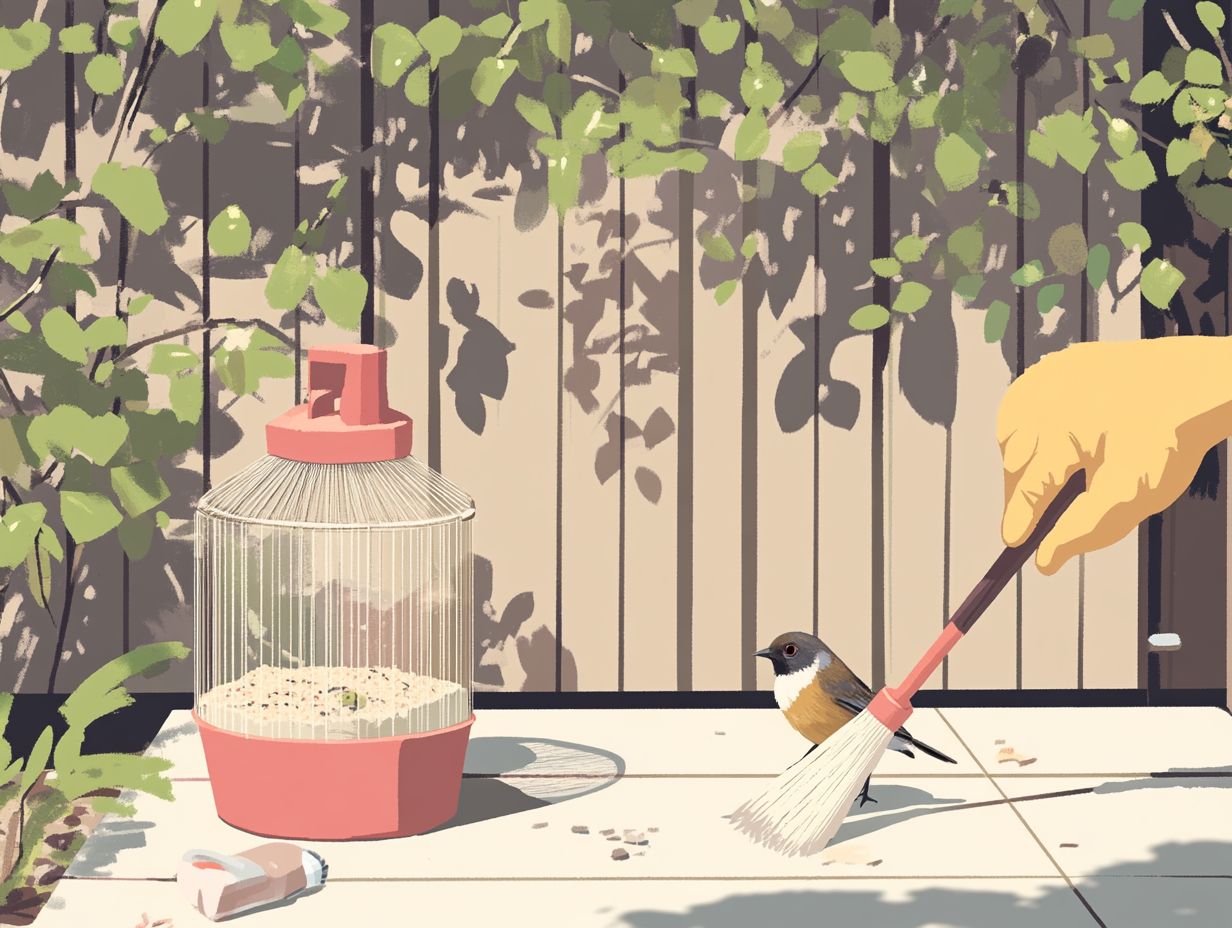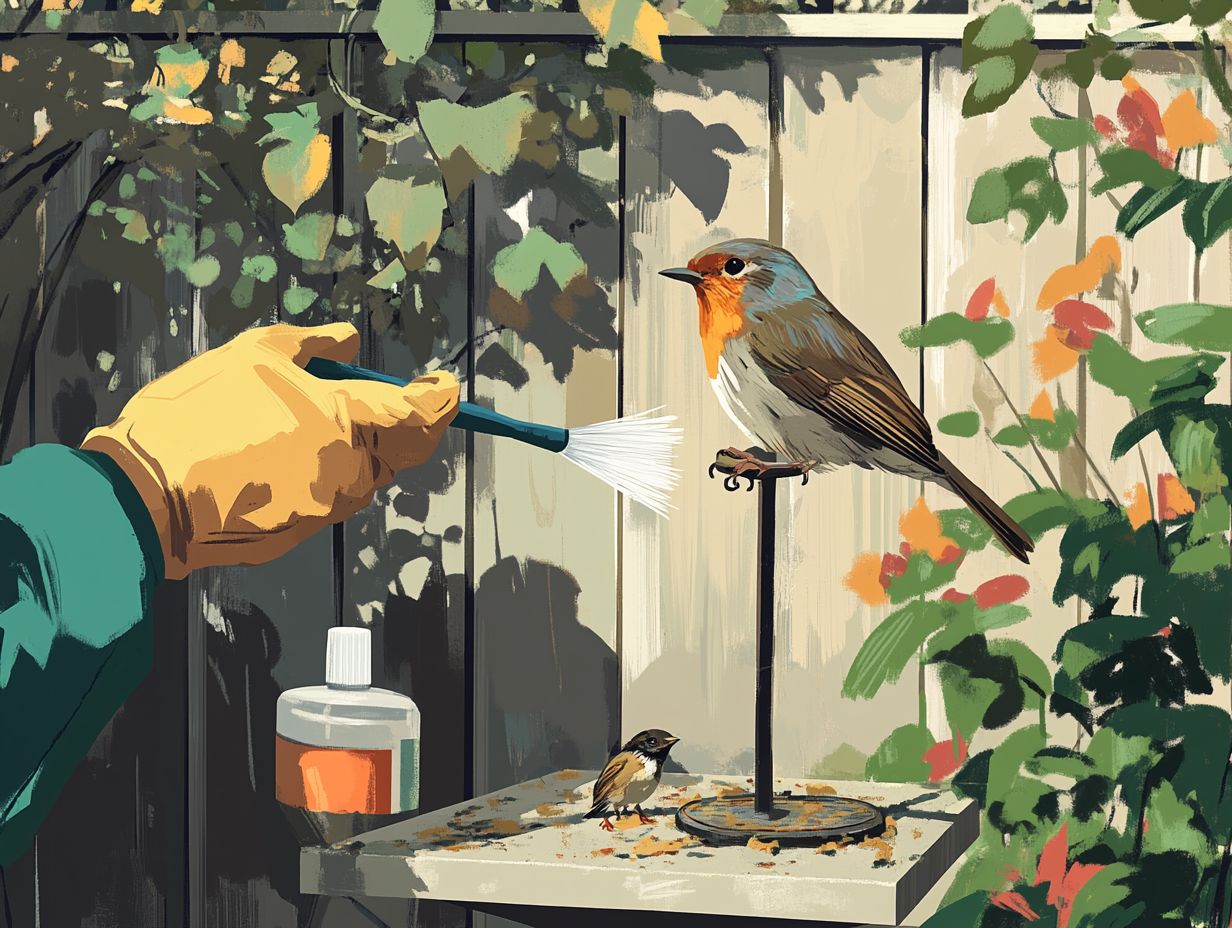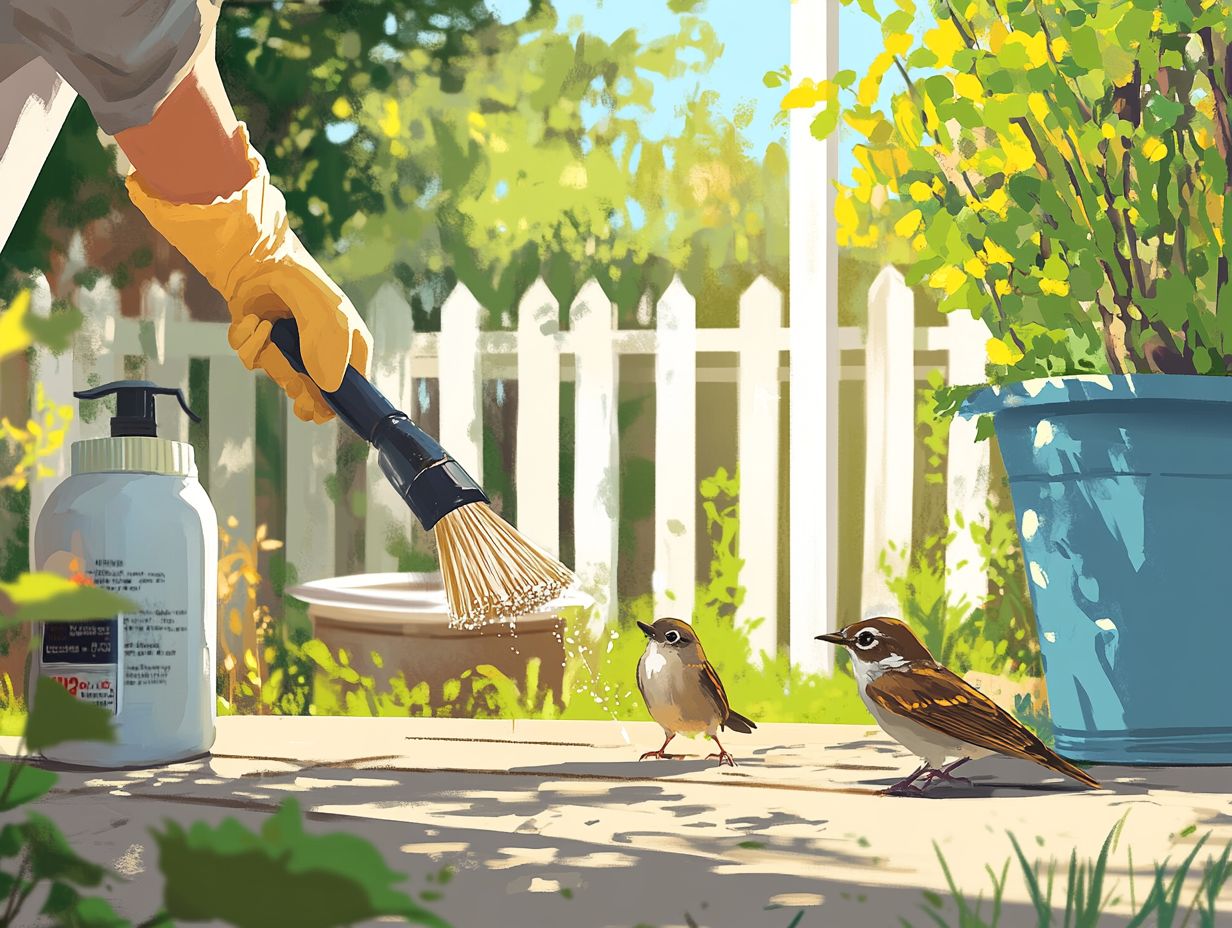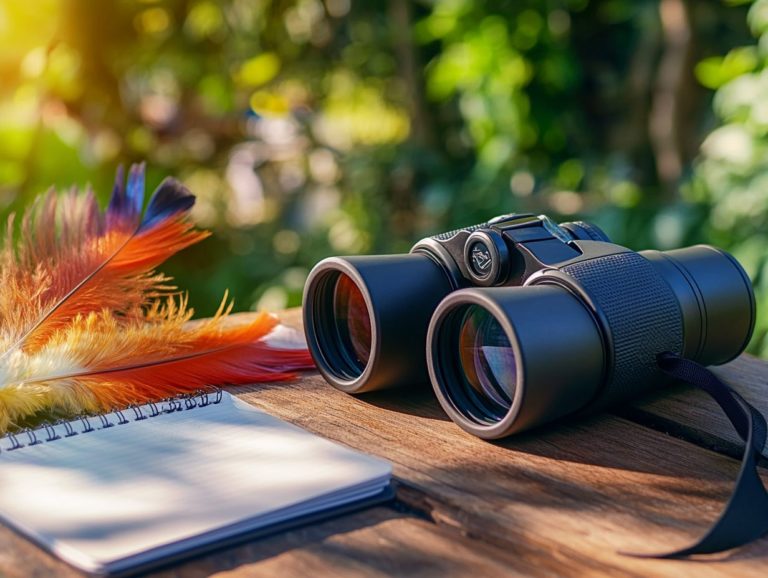How to Properly Clean Bird Feeders?
Cleaning bird feeders is vital for ensuring the health and well-being of the birds visiting your garden. A neglected feeder can quickly become a haven for harmful bacteria and pests, posing a risk of salmonellosis a disease caused by bacteria that can make birds sick which can drive birds away and jeopardize their health.
This guide emphasizes the importance of regularly cleaning your feeders. It details the necessary tools and provides a step-by-step process for a thorough cleanse. You ll also find insights on how often to conduct cleanings, feeder maintenance tips, and strategies to troubleshoot common problems.
By prioritizing this routine, you ll enhance your birdwatching experience while keeping it safe and enjoyable for your feathered friends. You ll also provide migration fuel during critical times.
Contents
Key Takeaways:

- Regularly cleaning bird feeders is crucial for maintaining the health of birds, including species like Pine Siskins and House Finches, and attracting them to your feeder.
- Essential tools and supplies for proper cleaning include a scrub brush, mild soap, gloves, and a reliable cleaning solution to ensure thorough sanitation.
- To properly clean a bird feeder, disassemble it, scrub with soap and water, rinse thoroughly with clean water, and allow it to dry completely before refilling especially important for feeders that might harbor bird diseases.
Why Cleaning Bird Feeders is Important
Cleaning your bird feeders is essential not just for the visual charm of your backyard, but also for the health and safety of the feathered guests, including hummingbirds and others, that depend on these feeding stations.
Regular maintenance is key to preventing the spread of bird diseases like salmonellosis, a type of eye infection in birds, and avian flu. These can wreak havoc on bird populations and create challenges for wildlife rehabilitators.
By recognizing the importance of maintaining clean feeders, you play a vital role in promoting bird health, which is essential for thriving ecosystems. This also enhances opportunities for stunning wildlife photography in your bird-friendly community as a participant in Project FeederWatch.
Impact on Bird Health and Attracting Birds
The health of the birds in your area hinges on the cleanliness of your bird feeders. Clean feeders can serve as vital sources of nourishment during migration or inadvertently facilitate the spread of bird diseases.
When feeders are left unattended and accumulate dirt, they can become breeding grounds for bacteria and parasites, posing serious health threats to different bird species. Salmonellosis thrives in unsanitary feeding environments and can spread rapidly in crowded feeding spots, resulting in alarming mortality rates, particularly during migration.
On the flip side, keeping your feeders clean ensures that birds get uncontaminated food. It also cultivates a safe environment that encourages migration and enhances the vibrancy of your local ecosystem by attracting diverse bird species.
Regularly cleaning and monitoring your feeders is essential for preventing issues such as moldy seeds or pest infestations. By adopting these vital practices, you can significantly contribute to the overall health and well-being of birds in your local habitat, helping them thrive.
Tools and Supplies Needed for Cleaning
To effectively clean your bird feeders and safeguard the health of visiting birds, including hummingbirds and finches, you’ll need specific tools and supplies. These include a bleach solution and other cleaning agents that will help you create a safe and healthy feeding environment.
Essential Items for Proper Cleaning

Essential items for maintaining your bird feeders include brushes for scrubbing, bleach to clean and disinfect, and a wood sealer. These items help shield wooden feeders from the elements, ensuring their durability and functionality.
Beyond these basics, incorporating copper feeders, endorsed by experts like Jolie Kerr, can enhance the performance of your feeding stations. The natural properties of copper not only elevate the aesthetic appeal but also inhibit the growth of harmful bacteria, ensuring that your seeds stay fresh and mold-free.
Seed deflectors are particularly beneficial; they guide seeds directly to the feeding area, minimizing waste and keeping the surroundings tidy. By integrating these components into your setup, you can significantly reduce health risks for wild birds while creating a safe and inviting dining experience that supports a variety of species.
Step-by-Step Guide to Cleaning Bird Feeders
Adhere to this comprehensive step-by-step guide to meticulously clean your bird feeders. This ensures they remain a safe haven for feeding birds while eliminating moldy seeds and the risk of avian diseases.
Instructions for Thorough Cleaning
Thorough cleaning is crucial for maintaining bird health and preventing the spread of avian diseases. Fortunately, it can be easily achieved by following straightforward maintenance instructions from organizations like the Cornell Lab of Ornithology.
By adhering to a few simple steps, you can use a diluted bleach solution to effectively sanitize your feeders and water sources. This process eliminates residue and potential pathogens, harmful germs that can make birds sick, fostering a hygienic environment that supports diverse bird species.
A well-maintained feeder will attract healthier birds, including those sought by wildlife photographers. This significantly increases your chances of spotting vibrant species that might otherwise shy away from unclean areas.
This cleaning routine protects your avian visitors and enhances your experience as a wildlife photographer. You’ll be able to capture breathtaking images of your feathered friends in a thriving habitat that supports diverse bird populations.
Frequency and Timing of Cleaning
Establishing a regular cleaning schedule for your bird feeders is essential for maintaining optimal feeder upkeep. This is critical for the well-being of the vibrant birds that visit your backyard.
By prioritizing this routine, you create a welcoming environment that fosters the well-being of your feathered friends, including those attracted to bird baths while enhancing your overall birdwatching experience.
Recommended Cleaning Schedule

A well-planned cleaning schedule for your bird feeders can greatly enhance maintenance and boost bird health by preventing the spread of harmful pathogens.
For optimal results, aim to clean seed feeders every two weeks. Meanwhile, suet and nectar feeders should be refreshed weekly to fend off mold and bacterial growth.
If you re keen on attracting a diverse array of species, consider alternating the types of feed such as sunflower seeds and nectar on a bi-weekly basis, including blends like Big Bear Blend. This approach keeps visiting birds healthy and well-nourished.
Rotating the locations of your feeders every few months helps maintain cleanliness and encourages a delightful variety of bird visits. This transforms your backyard into a vibrant hub for wildlife photography opportunities while preventing issues like mold and pests.
By embracing these thoughtful cleaning and feeding strategies, you ll find your avian visitors truly thriving, contributing to healthy bird-friendly communities. Mark your calendar to ensure your feeders are cleaned regularly. Your birds will thank you!
Troubleshooting Common Issues
By troubleshooting common issues like mold, pests, and other concerns in your bird feeders, you can elevate your feeder maintenance game. This significantly enhances the overall well-being of the birds that visit, especially during migration seasons.
How to Handle Mold, Pests, and Other Problems
Dealing with problems like moldy seed and pests is vital for bird health. This ensures a safe feeding environment while considering avian diseases, which are diseases that affect birds.
One of the best strategies you can employ to combat mold is to regularly inspect and replace seed. Additionally, keep feeders clean and dry. A simple mixture of white vinegar and water can serve as an effective sanitizer for your feeders, eliminating mold spores and promoting a bird-friendly environment.
For pest control, sprinkling diatomaceous earth around feeders can deter insects, all while remaining safe for your avian visitors, including those monitored by organizations like the National Wildlife Health Center. Taking timely action is essential; addressing these issues promptly not only safeguards the well-being of backyard birds but also creates a thriving environment where they can feed without the looming threat of harmful organisms.
Frequently Asked Questions
What supplies do I need to properly clean my bird feeders?

You will need a bucket or basin, soap or mild detergent, a scrub brush, and a hose or clean water source. These supplies will ensure thorough sanitation of your bird feeders.
How often should I clean my bird feeders?
Make it a habit to clean your bird feeders at least once a month for the best care! Clean them more frequently if they become visibly dirty or show signs of mold or mildew, especially if you notice birds displaying symptoms of avian diseases.
Can I use bleach to clean my bird feeders?
No! Bleach can be harmful to birds and should not be used to clean bird feeders. Stick to soap or mild detergent for safe and effective cleaning, especially when considering the health of your feathered friends.
What is the best way to clean tube-style bird feeders?
To properly clean a tube-style bird feeder, soak it in hot, soapy water for 10-15 minutes. Then, use a brush or bottle brush to scrub the inside and rinse thoroughly with clean water. This ensures that the feeder remains free from harmful bacteria and mold.
Is it necessary to disinfect bird feeders?
It is not necessary to disinfect bird feeders unless there has been an outbreak of disease among birds in your area, such as salmonellosis or avian flu. In that case, it is recommended to use a 10% bleach solution to disinfect the feeders.
Can I clean my bird feeders with just water?
No! It is important to use soap or mild detergent to effectively remove dirt, bacteria, and mold from bird feeders. Simply rinsing with water may not fully clean the feeders and could leave harmful pathogens present for visiting birds.






